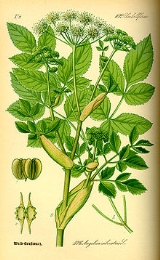
Wild Angelica
Encyclopedia
Wild Angelica is a species
of plant
that grows about one metre tall. It has broad, double-finned leaves
. The stem
is coarse, tubular and violet at the bottom, with broad leaf shafts.
At the top the stem has fine hairs.
The flowers are green-white.
Wild Angelica grows on grazing grounds, cultured land and along stream
s.
It is said that the plant is useless for food, but it is known that it has been used as a vegetable
until the 20th century.
The plant prevents scurvy
, and it can be stored. The stem was eaten fresh, and the leaves could be boiled to a stew for storage. It could later be cooked up with milk
into a tasty dish.
In dire times the Wild Angelica has been an important source of nutrition.
The plant has also been used for dyeing
.
It has recently been determined to be an invasive weed in New Brunswick and Cape Breton, Nova Scotia, Canada. "Accorting to the New Brunswick Invasive Species Council, unless this species is controlled, Woodland Angelica could spread throughout Canada, overwhelming other vegetation."
Species
In biology, a species is one of the basic units of biological classification and a taxonomic rank. A species is often defined as a group of organisms capable of interbreeding and producing fertile offspring. While in many cases this definition is adequate, more precise or differing measures are...
of plant
Plant
Plants are living organisms belonging to the kingdom Plantae. Precise definitions of the kingdom vary, but as the term is used here, plants include familiar organisms such as trees, flowers, herbs, bushes, grasses, vines, ferns, mosses, and green algae. The group is also called green plants or...
that grows about one metre tall. It has broad, double-finned leaves
Leaf
A leaf is an organ of a vascular plant, as defined in botanical terms, and in particular in plant morphology. Foliage is a mass noun that refers to leaves as a feature of plants....
. The stem
Plant stem
A stem is one of two main structural axes of a vascular plant. The stem is normally divided into nodes and internodes, the nodes hold buds which grow into one or more leaves, inflorescence , conifer cones, roots, other stems etc. The internodes distance one node from another...
is coarse, tubular and violet at the bottom, with broad leaf shafts.
At the top the stem has fine hairs.
The flowers are green-white.
Wild Angelica grows on grazing grounds, cultured land and along stream
Stream
A stream is a body of water with a current, confined within a bed and stream banks. Depending on its locale or certain characteristics, a stream may be referred to as a branch, brook, beck, burn, creek, "crick", gill , kill, lick, rill, river, syke, bayou, rivulet, streamage, wash, run or...
s.
It is said that the plant is useless for food, but it is known that it has been used as a vegetable
Vegetable
The noun vegetable usually means an edible plant or part of a plant other than a sweet fruit or seed. This typically means the leaf, stem, or root of a plant....
until the 20th century.
The plant prevents scurvy
Scurvy
Scurvy is a disease resulting from a deficiency of vitamin C, which is required for the synthesis of collagen in humans. The chemical name for vitamin C, ascorbic acid, is derived from the Latin name of scurvy, scorbutus, which also provides the adjective scorbutic...
, and it can be stored. The stem was eaten fresh, and the leaves could be boiled to a stew for storage. It could later be cooked up with milk
Milk
Milk is a white liquid produced by the mammary glands of mammals. It is the primary source of nutrition for young mammals before they are able to digest other types of food. Early-lactation milk contains colostrum, which carries the mother's antibodies to the baby and can reduce the risk of many...
into a tasty dish.
In dire times the Wild Angelica has been an important source of nutrition.
The plant has also been used for dyeing
Dyeing
Dyeing is the process of adding color to textile products like fibers, yarns, and fabrics. Dyeing is normally done in a special solution containing dyes and particular chemical material. After dyeing, dye molecules have uncut Chemical bond with fiber molecules. The temperature and time controlling...
.
It has recently been determined to be an invasive weed in New Brunswick and Cape Breton, Nova Scotia, Canada. "Accorting to the New Brunswick Invasive Species Council, unless this species is controlled, Woodland Angelica could spread throughout Canada, overwhelming other vegetation."

